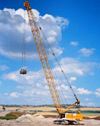
SC&RA Says Planned Crane Database Won't Boost Safety
In a July 6 letter to New York City Mayor Michael Bloomberg, the executive vice president of the Specialized Carriers & Rigging Association says only one 2007-2008 tower crane failure was attributed to component failure, and a database would not have helped to predict or prevent that failure. A national tower crane database may be impossible to achieve, Joel M. Dandrea wrote, because close to 1 million interchangeable crane components are in service in the United States alone, and most of those parts bear no individualized ID marking.
Dandrea wrote the letter in response to a plan by building officials in New York, Chicago, and Philadelphia. They are creating a new database to share critical information about active tower cranes in their cities. The plan is the latest push to improve crane safety to avoid crane collapses after two New York City crane accidents left nine people dead in 2008. In any given day, there are more than 50 active tower cranes in those three cities alone. "This great use of technology will undoubtedly improve the ability of the building officials to make construction sites safer for all. Regulating cranes will protect public safety and the workers," said David Perecman, a New York construction accident lawyer.
But Dandrea's letter said federal OSHA's proposed standard for cranes and derricks, which SC&RA participated in writing, is the plan that should be used. And he said NYC's Department of Buildings refused to accept input from Sc&RA. "SC&RA recognizes New York City's Department of Buildings efforts to eliminate incidents within the crane industry, however, our members believe the development and implementation of such a database will severely and negatively impact the crane and rigging industry due to unsubstantiated and unnecessary tracking of all tower crane components throughout the crane's lifetime," he wrote. The letter estimates 49,140,000 lifts with tower cranes have been made in 2007-2008, based on an estimate of 105,000 lifts per day, and there were only six prominent incidents during the period -- with all but one thought to have resulted from human error as the root cause, not crane or component failure, he wrote.
The city officials said their goal is to share information about the design and building of these tower cranes, as well as track other important details, including manufacturer recalls, crane equipment failures, inspection records, operational failures, and construction site accidents. Crane tracking is one of the recommendations that developed from the High Risk Construction Oversight study, which the Department of Buildings launched in July 2008 in response to an increase in construction accidents. At outlined by the cities, Initially the program will only cover New York City, Chicago, and Philadelphia, but other cities across the country are expected to join the common database in the coming months.